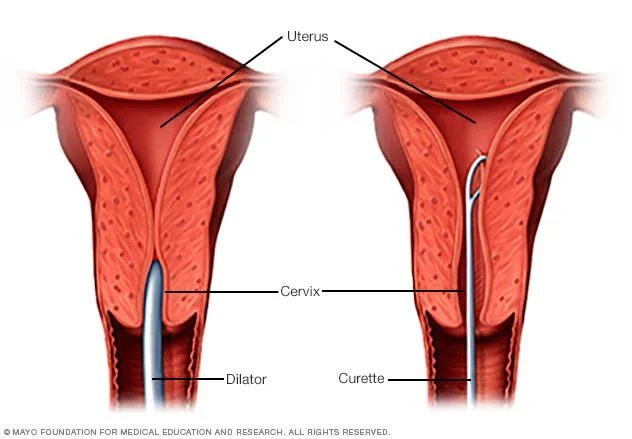
Dilation and Curettage (D&C): A Comprehensive Overview
February 08, 2024 12:37
November 03, 2024 9:12
Introduction:
Dilation and Curettage (D&C) is a surgical procedure (Abortion) that has been historically used for various therapeutic and diagnostic indications. This article aims to provide a comprehensive overview of D&C, including its history, indications, contraindications, complications, and legal status. It is important to note that specific laws and regulations regarding D&C may vary across countries and regions, underscoring the importance of seeking local information and professional advice.
History of Dilation and Curettage:
Dilation and Curettage has been performed for centuries, though formal medical recognition of the procedure began in the 19th century. It became popular as a therapeutic and diagnostic tool for various uterine conditions, including pregnancy-related complications.
Indications for Dilation and Curettage:
D&C is used for both diagnostic and therapeutic purposes, including:
1. Diagnostic:
- Evaluation of abnormal uterine bleeding: D&C allows sampling of uterine tissue to investigate the underlying causes of abnormal bleeding.
- Investigation of infertility: D&C may be recommended to examine the uterine lining or remove abnormal tissue that could contribute to infertility.
- Diagnosis of uterine cancer: Tissue samples obtained during D&C can help diagnose and stage uterine cancer.
2. Therapeutic
- Evacuation of retained products of conception: In cases of incomplete miscarriage or elective abortion complications, D&C can be used to remove remaining pregnancy tissue from the uterus.
- Treatment of abnormal uterine growths: D&C may be an option to remove uterine polyps or fibroids that are causing symptoms or affecting fertility.
- Addressing heavy or prolonged menstrual bleeding: D&C can help alleviate symptoms by removing excess tissue from the uterine lining.
Steps of the Procedure:
D&C involves two main steps: dilation (widening) of the cervix and curettage (scraping) of the uterus lining. Here’s a brief overview of each step:
1. Dilation: Prior to the procedure, the cervix is dilated using medication or surgical instruments. This allows access for the curette to remove the uterine tissue.
2. Curettage: A curette, a spoon-like instrument, is inserted into the uterus through the cervix. The doctor carefully scrapes the uterine lining, removing any abnormal tissue or conducting a biopsy for further analysis.
Contraindications for Dilation and Curettage:
While D&C is generally safe, certain contraindications and precautions should be considered, such as:
- Active pelvic inflammatory disease (PID): Infection in the pelvic area can increase the risk of complications during and after D&C.
- Coagulation disorders: Patients with bleeding disorders or taking anticoagulant medication may have an increased risk of excessive bleeding during the procedure.
- Known or suspected uterine cancer: In cases where uterine cancer is suspected or confirmed, alternative interventions may be more appropriate.
Complications of Dilation and Curettage:
Complications associated with D&C are rare but can occur. These may include:
- Infection: D&C creates a temporary opening in the cervix, increasing the risk of infection if proper sterile techniques are not followed.
- Uterine perforation: Accidental puncturing or perforation of the uterus during the procedure is a rare but potential complication.
- Excessive bleeding: While some bleeding is expected after the procedure, excessive or prolonged bleeding may require medical attention.
- Asherman’s syndrome: Rarely, D&C may lead to the development of Asherman’s syndrome, characterized by the formation of scar tissue in the uterus.
Legal Status in the US and EU:
In both the United States and the European Union, D&C is a legal procedure that is considered safe and commonly performed. However, the specific regulations and guidelines surrounding D&C may vary from country to country, and healthcare providers must adhere to their respective medical and legal standards.
Conclusion:
Dilation and Curettage (D&C) has a long history as a valuable diagnostic and therapeutic procedure for various uterine conditions. Dilation and Curettage (D&C) is a well-established gynecological procedure used for both diagnostic and therapeutic purposes. By dilating the cervix and scraping the uterine lining, D&C provides valuable insights and potential treatment options for various uterine conditions.
It is important for individuals considering D&C to understand its indications, contraindications, and potential complications, as well as the legal status in their country. While this article provides general information, it is essential to consult with a healthcare professional for personalized advice and guidance.
Author
 Dr. Kopp Kallner. M.D. in Obstetrics & Gynecology, Columbia University Medical School.
Dr. Kopp Kallner. M.D. in Obstetrics & Gynecology, Columbia University Medical School.

 Français
Français Deutsch
Deutsch Español
Español Русский
Русский